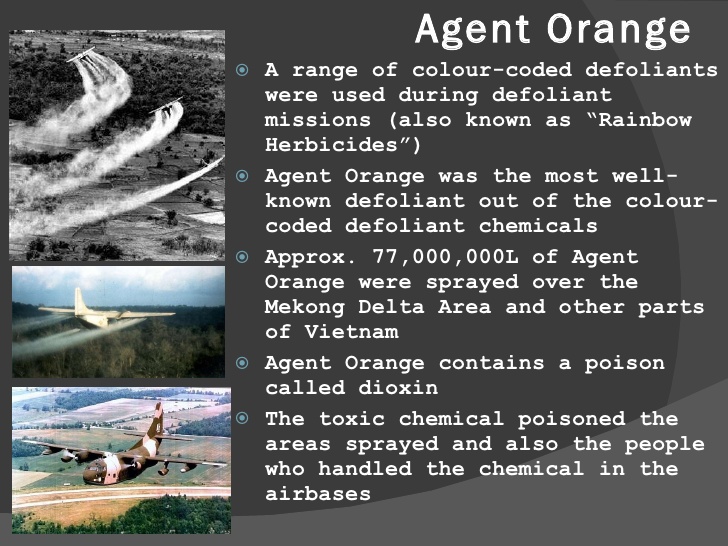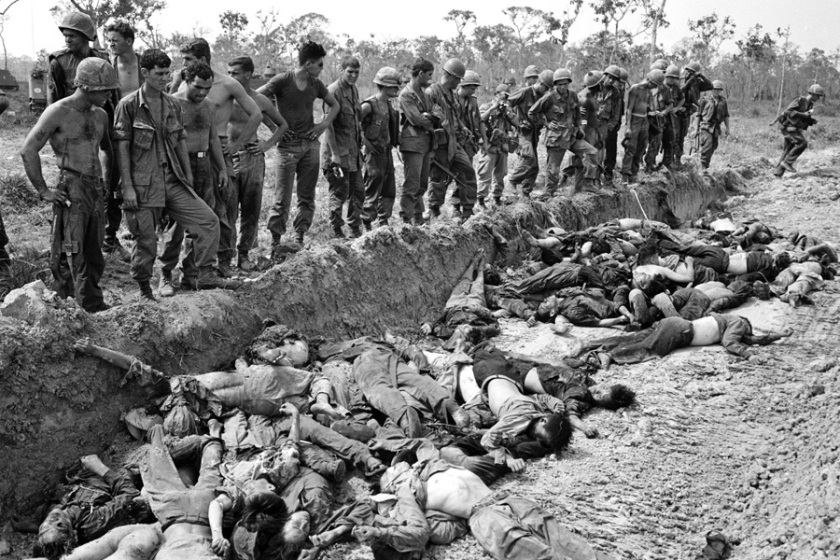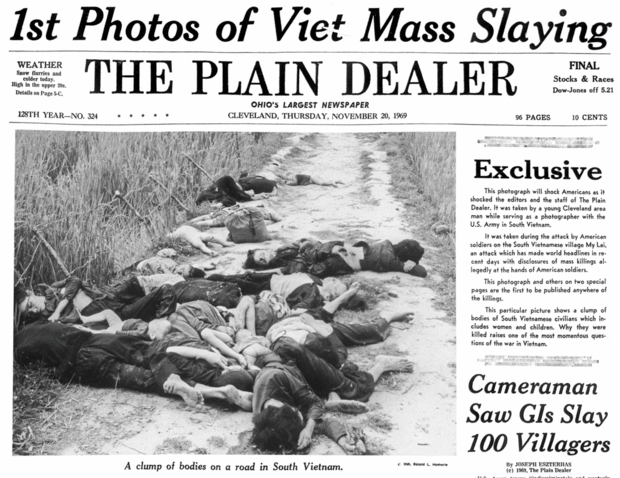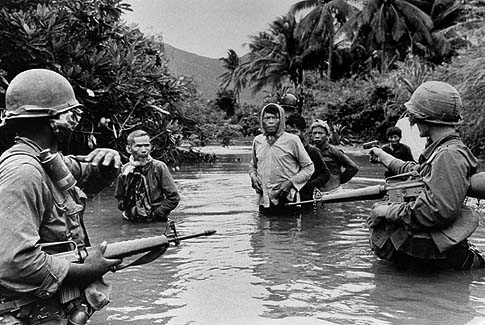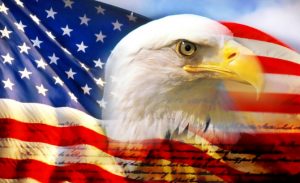
Views: 2599
Atrocities and war crimes are subjectively defined as acts of violence that exceed military necessity. All war includes atrocities. The stress of combat includes a build up of emotion during action that leads to vicious attacks on the enemy when the opportunity arises. American military units are trained and indoctrinated to avoid inhuman treatment of enemy combatants. Soldiers who violate the norms are prosecuted. This reduces but does not eliminate the problem.
Photo of Vietnamese civilians killed by an American unit
Atrocities During the Vietnam War
The actions of armies in war have seldom been as humane as the modern American military — in the 20th Century alone there are boundless documented examples of horrific acts by the Germans, the Japanese and the Soviet Red Army in World War II, or by North Korea in the 1950s, and others later than that. Before the 20th Century, ugly butchery was common in war.
In Vietnam specifically, the Communist forces regularly perpetrated atrocities on Americans as well as the Vietnamese civilian population. A few examples:
-
- In battles at Ia Drang (23 October to 20 November 1965), NVA troops slaughtered U.S. wounded. Most bodies recovered were shot in the head or back. At other locations, wounded American soldiers were tied to trees, tortured, and then murdered
- On 6 December 1967, Viet Cong massacred 252 civilians in a vengeance attack on Dak Son, an anti-communist Montagnard village
- During the 1968 Tet offensive, the North Vietnamese massacred 5,800 civilians at Hue
- Terrorism was an integral part of Communist strategy in Vietnam; terrorist attacks in Saigon regularly killed innocent women and children
- Khmer Rouge (Cambodian Communists) were particularly brutal; as guerrillas they slaughtered whole villages — after gaining power estimates of dead from their actions run into millions
- Treatment of prisoners in Communist camps included routine brutality along with torture and psychological abuse
In total, from 1957 to 1973, the Viet Cong assassinated 36,725 South Vietnamese and abducted another 58,499. The VC death squads focused on leaders at the village level and on anyone who improved the lives of the peasants such as medical personnel, social workers, civil engineers, and schoolteachers. For the Communist forces, atrocities were a matter of policy and were not hidden or punished.
Despite continuous commission of such atrocities, and many more small scale sadistic acts designed to terrorize U.S. troops and punish cooperating Vietnamese, many people cling to the belief that U.S. troops were barbaric while the Communist forces were noble freedom fighters. This is partially a media-created paradigm, based on over-reporting of U.S. or South Vietnamese faults while under-reporting the others. It is also based on endless repeating of a few true stories of U.S. transgressions along with the creation of myths about other events that did not happen or were wildly exaggerated.
The 1971 “Winter Soldier” hearings organized by the Vietnam Veterans Against the War, portrayed Vietnam as the locus of continuous atrocities and sub-human behavior by American soldiers. Serious doubts have been raised about the credibility of the testimony and some of the presenters at the Winter Soldier meeting. Researchers have pointed out that some presenters used false identities and all refused to give military investigators the dates, sites, and names of perpetrators of atrocities that they had reported. A series of falsehoods and half truths were widely publicized as reality, and made the theme of popular books and movies, making it harder to appreciate what really did happen in Vietnam.
American Atrocities in Vietnam
Unfortunately American soldiers did commit atrocities and lesser acts of cruelty in Vietnam. Any city containing half a million young men will have rapes, murders, and assaults. When that city is made up of military men engaged fighting a tough, brutal and determined enemy the “crime rate” will be higher.
The overwhelming majority of civilian deaths in Vietnam were the result of the basic tactics and weapons used. Artillery and aerial bombardment was often used in Vietnam to minimize troop losses, a strategic choice that caused suffering and death for civilians. But there were proportionally fewer such casualties than in either World War II or the Korean War. In WW II for example, American firepower doctrine regularly leveled towns, villages, and cities, causing large numbers of civilian as well as military casualties. In Vietnam, where many civilians were cooperating with the enemy, the Communist NVA/VC infiltrated the civilian population making discrimination during bombardment difficult or impossible to practice.
During the period 1 January 1965 to 31 August 1973, there were 241 cases which involved allegations of war crimes by United States Army troops (excluding My Lai). One hundred and sixty of these cases, upon investigation, were determined to be unsubstantiated. Substantiated allegations of war crimes violations committed in Vietnam by U.S. personnel were prosecuted. From January 1965 through August 1973, 36 cases involving war crimes allegations against Army personnel were tried by court-martial. Between 1965 and 1973, 201 U.S. soldiers and 77 Marines were convicted of serious crimes against the Vietnamese. All in all, this is a very small number given the size of the force and length of time involved. While critics say the number is small because crimes were not prosecuted, the truth is that American soldiers in Vietnam for the most part behaved well.
The Phoenix Program
In December 1967 an existing program was given new emphasis and renamed Phoenix. The South Vietnamese side was called Phung Hoang, after a mythical bird that appeared as a sign of prosperity and luck. CORDS made Phoenix a high priority and within weeks expanded intelligence centers in most of South Vietnam’s provinces. Phoenix attacked the Viet Cong Infrastructure (VCI), covert operatives within South Vietnam who were the most important component of the Viet Cong movement.
Virtually every village in South Vietnam had a VCI cell made up of a Communist Party secretary, a finance and supply unit, information and culture, social welfare, and proselytizing sections to gain recruits from among the civilian population. They answered up a chain of command, with village cadre answering to the district, then to the province, and finally to a series of regional commands which, in turn, took orders from Hanoi (North Vietnam).
To counter the VCI, Phoenix relied on local militia and police rather than the military as the main operational force of the program. Provincial Reconnaissance Units (PRU), recruited and trained by the Central Intelligence Agency (CIA), were the best action arm available to Phoenix.
Phoenix has been portrayed as a rogue operation, a shadowy nexus of torture and assassination. But a more accurate picture of Phoenix reveals a wartime organization with a difficult mission that operated within a system of rules. Special laws, called An Tri, allowed the arrest and prosecution of suspected Communists, but only within the legal system. Moreover, to avoid abuses such as phony accusations for personal reasons, or to rein in overzealous officials who might not be diligent enough in pursuing evidence before making arrests, An Tri required three separate sources of evidence to convict any individual targeted for neutralization. If a suspected VCI was found guilty, he or she could be held in prison for two years, with renewable two-year sentences totaling up to six years. While this was probably fair on its surface, hardcore VCI were out in six years at most and then rejoined the guerrillas.
Between 1968 and 1972 Phoenix neutralized 81,740 Viet Cong, of whom 26,369 were killed. This was a large piece taken out of the VCI; the program was quite successful in destroying the VCI in many important areas. These statistics have been used to suggest that Phoenix was an assassination program, but it was not. People were killed, but statistics show that more than two-thirds of neutralized VC were captured, not killed. Indeed, only by capturing Viet Cong could Phoenix develop the intelligence needed to net additional Viet Cong. Abuses did occur, such as torture, which US advisers could not always halt, but most advisers understood the adage that dead Viet Cong do not tell about live ones.
Phoenix was also accused of sometimes targeting civilians, because the VCI did not wear military uniforms. But the VCI was an integral aspect of the Communist insurgency and a legitimate target.
Material in this section based on the comprehensive review article: CORDS/Phoenix: Counterinsurgency Lessons from Vietnam for the Future by Dale Andrade and LTCOL James H. Willbanks, US Army, Retired, Ph.D, Military Review, March-April 2006.
The My Lai Massacre
The worst case of an American war crime was the massacre at My Lai, on 16 March 1968, in the aftermath of the Tet Offensive. The village and surrounding area were assaulted to clear Viet Cong known to be operating in the area. A company of soldiers from Americal Division, following ill-defined orders and rules of engagement, murdered 400 to 500 Vietnamese civilians. The court martial transcripts are sickening to read as they include the indiscriminate execution of men, women, babies and children along with sexual assault and other brutality perpetrated upon the victims, individually and in groups. A second massacre of ninety to one hundred civilians occurred in the neighboring hamlet of Co Luy at the same time.
The action at My Lai was initially classified as a victory with a claim that 128 enemy combatants had been killed. After reports of atrocities were filed by military witnesses, an informal investigation amounted to a cover-up, finding that a small number of civilian deaths had occurred, but that they had been unavoidable. The investigating officer stated, “The allegation that US Forces shot and killed 450-500 civilians is obviously a Viet Cong propaganda move to discredit the United States in the eyes of the Vietnamese people.” Nothing further was done until after 2 April 1969, when a soldier-witness mailed a letter detailing the My Lai Massacre to thirty prominent people in Washington, D.C. — including President Nixon, the Secretary of Defense, the Chairman of the Joint Chiefs of Staff, Senators and Congressmen. The media latched onto the story and a public firestorm began as the U.S. was subjected to worldwide criticism. On 24 November 1969, the Secretary of the Army ordered an independent inquiry into the massacre that eventually brought all the facts to light.
The despicable acts were done by average American boys in a normal unit. What explanation can there be? Several factors have been suggested by investigators:
- Command responsibility: inexperienced leadership, ambiguous orders, lack of control during the operation
- Callousness and fear developed from experiences of cruelty and deviousness at the hands of enemy combatants or civilians cooperating with them
- Dehumanizing of Vietnamese by racial attitudes
- Insensitivity due to high civilian casualties caused by bombardment
- Misplaced objectives due to “body count” as a success metric
All of these and more contributed to the My Lai Massacre, but cannot excuse it.
The story is not all bad. Command policy was clear: MACV directives established that, “a war crime is the business of the United States, regardless of the nationality .. of the victim,” and required every service member in Vietnam to report incidents which might constitute war crimes. Another directive stated, “Firing on localities which are undefended and without military significance, is a war crime.” At My Lai, many individuals showed moral and physical courage, as well as compassion and humanity, in their attempts to intervene on behalf of the victims. Some refused orders to shoot civilians, others came to their senses during the action and withdrew. A helicopter pilot who observed apparent atrocities landed in front of a group of fleeing villagers, and ordered his gunner to point his weapon at the pursuing American soldiers while requesting assistance over the radio. This pilot and others reported what they saw to officers and chaplains, stimulating the first investigation. Others wrote to officials in the U.S. to get the story out.
My Lai is a shameful stain on the history of the U.S. military. The Secretary of the Army’s investigation led to courts-martial of many participants, for the civilian deaths or the cover up, most of which had to be dismissed for lack of evidence. Lt. Calley, the platoon leader at the center of the atrocity, was the only participant at My Lai found guilty and imprisoned.

Source: Olive Drab
Origins of images: Facebook, Twitter, Wikimedia, Wikipedia, Flickr, Google, Imageinjection, Public Domain & Pinterest.
Read our Disclaimer/Legal Statement!
Donate to Support Us
We would like to ask you to consider a small donation to help our team keep working. We accept no advertising and rely only on you, our readers, to keep us digging the truth on history, global politics, and international relations.


